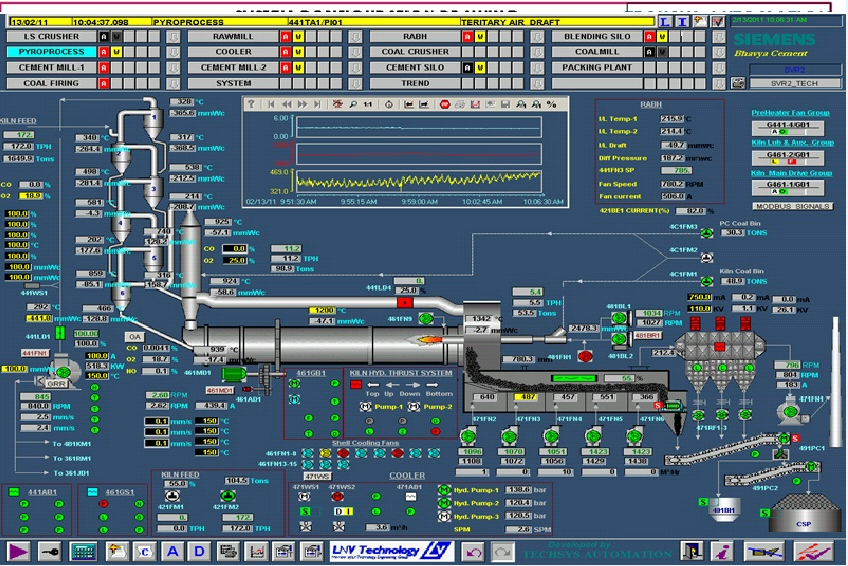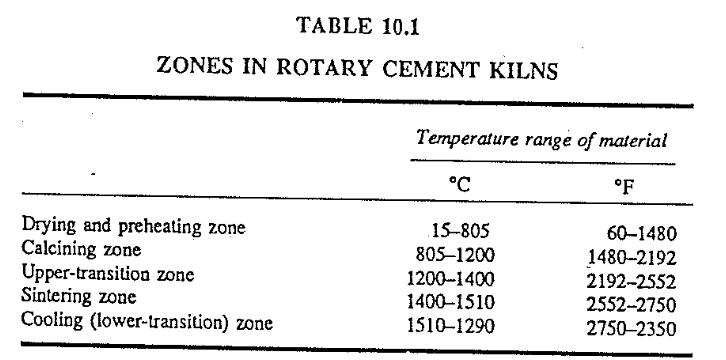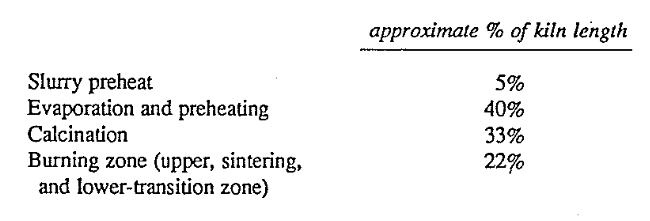Contents
click here to Download the Most Important 13 Books in Cement Industry
click here to Download the Most Important 13 Books in Cement Industry
EVERYTHING YOU NEED TO KNOW ABOUT REACTIONS ZONES IN THE ROTARY KILN

Controlling the kiln operation means keeping a watch on all the different zones and reactions that take place within the kiln system. The chemical reactions and phase formations taking place within the kiln are discussed in Chapter 7. None of these zones can be neglected or ignored if the kiln is to be operated properly. There are five distinct zones within the kiln, their location and length being different for each type of kiln system used. These zones are shown in Table 10.1

Kiln operators define the upper-transition, the sintering, and the lower transition zones as one complete uni referred to as the burning zone. The burning zone is that area in the kiln where clinker coating exists on the refractory surface.
IN the drying and preheating zone all the free water in the feed is removed and the temperature of the feed is raised to approximately ·805 C (1481 F) at which temperature calcination begins. During drying;the feedtemperature remains at 100 C (212 F) until all the free moisture is removed. Starting at a temperature of 550 C (1022 F) the chemically combined water in the clay minerals is also driven off. Thus, in this particular zone, the reactions taking place in succession are: raising the feed :temperature to the evaporation temperature, evaporating the free water, liberating the chemically combined water, and raising the feed to the calcining temperature.
From an operator’s viewpoint, the calcining zone is the most important zone that governs subsequent events in the burning zone. Calcination is the action through which carbon dioxide is driven off from limestone and magnesium carbonate, leaving free lime and magnesia:

Carbon dioxide dissociates from the feed and is carried away·by the kiln gases. Kiln feed that is not completely calcined before it enters the burning zone is difficult to burn and is one of the main reasons for upset kiln conditions. Thus, complete calcination of the kiln feed before it enters the burning zone is essential to proper burning of the clinker.
From the above reaction of limestone it follows that the formation of free lime in the calcining zone is accompanied by a corresponding reduction in the CaC03 (calcium carbonate) content in the feed. If samples were extracted in incremental distances along the length of the calcining zone, the rate of reaction taking place could be determined with reasonable accuracy as the feed travels down the kiln. Stopping a .kiln and extracting these samples from the feed bed, however, would not serve this purpose because the feed bed would continue to be calcined after the shutdown until the temperature of the feed fell below 805 C (1481 F). Research work has been done along this line by installing sample ports on the kiln shell and sampling the feed bed while the kiln remains in operation. The results obtained are revealing and of interest to the cement industry but such procedures are prohibitive, because of the high costs for the day-to-day control of the kiln operation.
On preheater and precalciner kilns this method of checking the calcining rate is not a problem because it is easy to sample the material as it leaves individual cyclone stages. Most dry-process kilns also have a sample port at the discharge end of the chain section that allows for analysis of the degree of calcination. In this case, however, the results are not as revealing because the sample point is at a location where calcination is usually just starting. Nevertheless, checking the calcination rate on a weekly or monthly basis for dry kilns and on a daily” basis for precalciner and pre heater kilns is a recommended procedure.
For a continuous indication of the calcining conditions while the kiln is in operation, the operator monitors the gas analyzer that records, among other gas components, the C02 content of the kiln exit gases. Because it is an important control function, C02 control is discussed in more detail in the chapter on kiln controls.
The term upper-transition zone
is relatively new to kiln nomenclature. In the chapter on heat transfer, mention is made of the interim-phase for mations once the feed has been calcined. There is an area in the kiln where calcination and interim-phase formations overlap each other. Some of the finer particles, or the ones that were most favorably exposed to the hot kiln gases on the feed-bed surface, can reach complete calcination and start to react with the alumina, silica, or iron to form these interim compounds. With other particles, calcination would not be finished and thus no liquid formation would begin. Engineers generally refer to this area as the upper transition zone. This is identified as the upper third of the area where clinker coating is formed in the kiln. This area is located inside the kiln, directly behind the flame where the feed bed has a “dark” color. In the temperature diagrams shown in the chapter on heat transfer, this area is identified by the sudden rapid rise in material temperature just at the start of the burning zone.
The sintering zone
is where t11e final stages of clinker compound formation takes place. Unstable interim phases such as CsA3 and C2F transform into the stable compounds C3A -and C4AF. Also, C2S combines with more free lime to form the all-important compound c3s. sintering in the heart of the burning zone is an exothermic process; i.e., heat is evolved instead of being absorbed during this process. Sintering takes place in the middle part of the burning zone directly under the illuminated part of the flame. It is here where the most viscous behavior of the clinker bed can be observed and where the material temperatures are the highest, i.e., > 1400 C (2552 F).
The cooling (or Lower-transition) zone
entails, usually with few exceptions, the last 3-6 m (10-20 ft) of the discharge end of the kiln. Contrary to popular misconceptions, the process of clinker formation is not complete when the material has passed the hottest area. The manner in which the clinker is cooled greatly affects its quality. Depending on the location of the flame, cooling, i.e., solidification of the partly liquid compounds, can be either slow or rapid. It is generally true that rapid cooling is beneficial to both the quality of the clinker and its grindability. For rapid cooling, the sintering zone is very close to the discharge end; thus Ole clinker discharges from the kiln at a temperature of about 1370 C (2498 F). As soon as it enters the first quench compartment in the cooler it is rapidly cooled. Conversely, when the burning zone is located too far uphill, the clinker will reside for a longer time in the lower-transition zone, being slowly cooled, and thus discharged from Ole kiln at a temperature of around 1200 C (2192 F).
It is now of interest to discuss how the length of the above-mentioned zones can vary from one kiln system to another.
LONG WET-PROCESS KILNS
In a wet-process kiln, the feed enters the kiln in the form of a slurry, having a moisture content of approximately 30%. Various types of heat exchangers are used to remove this moisture from 01e slurry, the one most widely used being chains at the back end of the kiln, shown in Fig. 2.2. other kiln systems dry Ole slurry and pelletize the kiln feed before it enter the kiln, using 01e kiln exit gases for this purpose. Modem, large rotary kilns may use a series of heat exchangers; for example, steel cylinder drying chambers and chains. In some kilns the gases, before they enter the chain section, pass through a section where the interior of the kiln is divided lengthwise into four compartmenls over a length of approximately 20ft. This divides the feed bed and thus provides a better exchange of heat between the hot gases and the relatively cold feed. These devices are better known by the term trefoils.
The slurry, when it enters the kiln, has a temperature of approximately 38 C (100 F), rising to a chain discharge temperature of between 200- 260 C (392-500 F) in kilns with chain systems that dry all the moisture within the chains. On nodule kilns, i.e., when the feed still contains approximately 8-15% moisture when it leaves the chain system, the feed temperature will be around 100 C (212 F) at this location. Wet-process kilns in which all the free moisture is driven off in the chain system are usually more energy efficient but often show higher kiln exit dust losses, have a tendency toward mud-ring formations in the chains, and produce feed bed characteristics below the chain zone that are identical to a dry-process kiln. Kilns with chain systems that are designed to form and discharge nodules tend to be easier to control and have less tendency to generate dust flushes (kiln upsets) into the burning zone. From an operator’s ease-of control viewpoint the latter is clearly more desirable. In a typical wet process kiln, the various zones generally take up the following percentage of total kiln length:

THE DRY-PROCESS KILN
In the dry process, the feed enters the kiln in dry powder form. As in a wet kiln, the feed passes through a chain section whose primary function is to preheat the feed to a chain exit temperature of around 730 C (1346 F). Thus, whatever free moisture there is in both the feed and the chemically combined water, is driven off within the chain system. Calcination starts a few meters below the chain section. The typical length of various zones in a dry-process kiln are:

THE SEMIDRY (LEPOL) KILN
The drying, the dissociation of the chemical water, the preheating to calcining temperature, and even partial calcination in this system takes place outside the rotary kiln, i.e, in the grate preheater. Hence, the rotary kiln proper has only to complete the calcination and form the clinker com· pounds. The length of the zones in the Lepol kiln are thus quite different from the aforementioned kilns.

THE PREHEATER AND PRECALCINER KILNS
These kilns are fed dry’ powder feed at the upper stage of the preheater cyclone tower. Preheating, dissociation of the chemically combined water, and partial calcination of the feed, here too, takes place outside the rotary kiln. In a preheater kiln, the feed enters the rotary kiln approximately 30-40% calcined whereas in the precalciner kiln this feed can be up to 90% calcined. For this reason, the burning zone in a precalciner kiln is longer and the calcining zone shorter than on a preheater kiln as shown in the following:

click here to Download the Most Important 13 Books in Cement Industry
click here to Download the Most Important 13 Books in Cement Industry
Thanks but I have not more money for this booking
So
Sorry
Lower transition zone is not the Cooling zone!